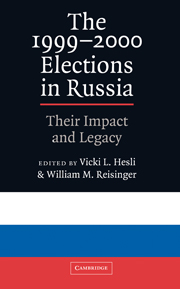Book contents
- Frontmatter
- Contents
- Contributors
- Acknowledgment
- SECTION I INTRODUCTION
- SECTION II PARTIES IN THE ELECTORATE
- 2 Television, Voters, and the Development of the “Broadcast Party”
- 3 Parties, Voters, and Foreign Policy
- 4 The Foreign Policy Implications of the Elections
- 5 Parties, Leaders, and Voters in the Parliamentary Election
- SECTION III THE ROLE OF REGIONAL POWER
- SECTION IV PARTIES AND INSTITUTIONS
- SECTION V CONCLUSION
- Bibliography
- Index
2 - Television, Voters, and the Development of the “Broadcast Party”
Published online by Cambridge University Press: 23 October 2009
- Frontmatter
- Contents
- Contributors
- Acknowledgment
- SECTION I INTRODUCTION
- SECTION II PARTIES IN THE ELECTORATE
- 2 Television, Voters, and the Development of the “Broadcast Party”
- 3 Parties, Voters, and Foreign Policy
- 4 The Foreign Policy Implications of the Elections
- 5 Parties, Leaders, and Voters in the Parliamentary Election
- SECTION III THE ROLE OF REGIONAL POWER
- SECTION IV PARTIES AND INSTITUTIONS
- SECTION V CONCLUSION
- Bibliography
- Index
Summary
Very few political parties have endured in the young Russian state since the collapse of the Soviet Union and one-party rule. What we can observe over time is an improved ability of those in power to create, market, and win election for political parties and presidential candidates. At times, this task was enormously difficult for the Russian president, as both Boris Yeltsin and Vladimir Putin encountered deep popular discontent with the economic and political problems of the post-Soviet state. Yet evidence ranging from the creation of the Russia's Choice progovernment party in 1993 to the election of Putin as the new president in 2000 suggests that the Kremlin has learned important lessons and improved its ability to use elections to consolidate its political power. Notably, the Yeltsin administration discovered the importance of favorable media treatment, plausible candidates, and crafting campaign statements that appealed to the Russian heartland.
While issues and government performance surely matter to Russian voters, the political fluidity and societal chaos have led to politicians, namely those in the Kremlin, relying more on short-term campaign appeals than on long-term accountability and plausibility for party formation. This chapter will argue that Russian politicians have learned these lessons well, leading to the creation of the “broadcast party,” that is, a political movement that relies heavily on television for its creation and electoral success – albeit not for its survival.
- Type
- Chapter
- Information
- The 1999–2000 Elections in RussiaTheir Impact and Legacy, pp. 29 - 50Publisher: Cambridge University PressPrint publication year: 2003
- 6
- Cited by



